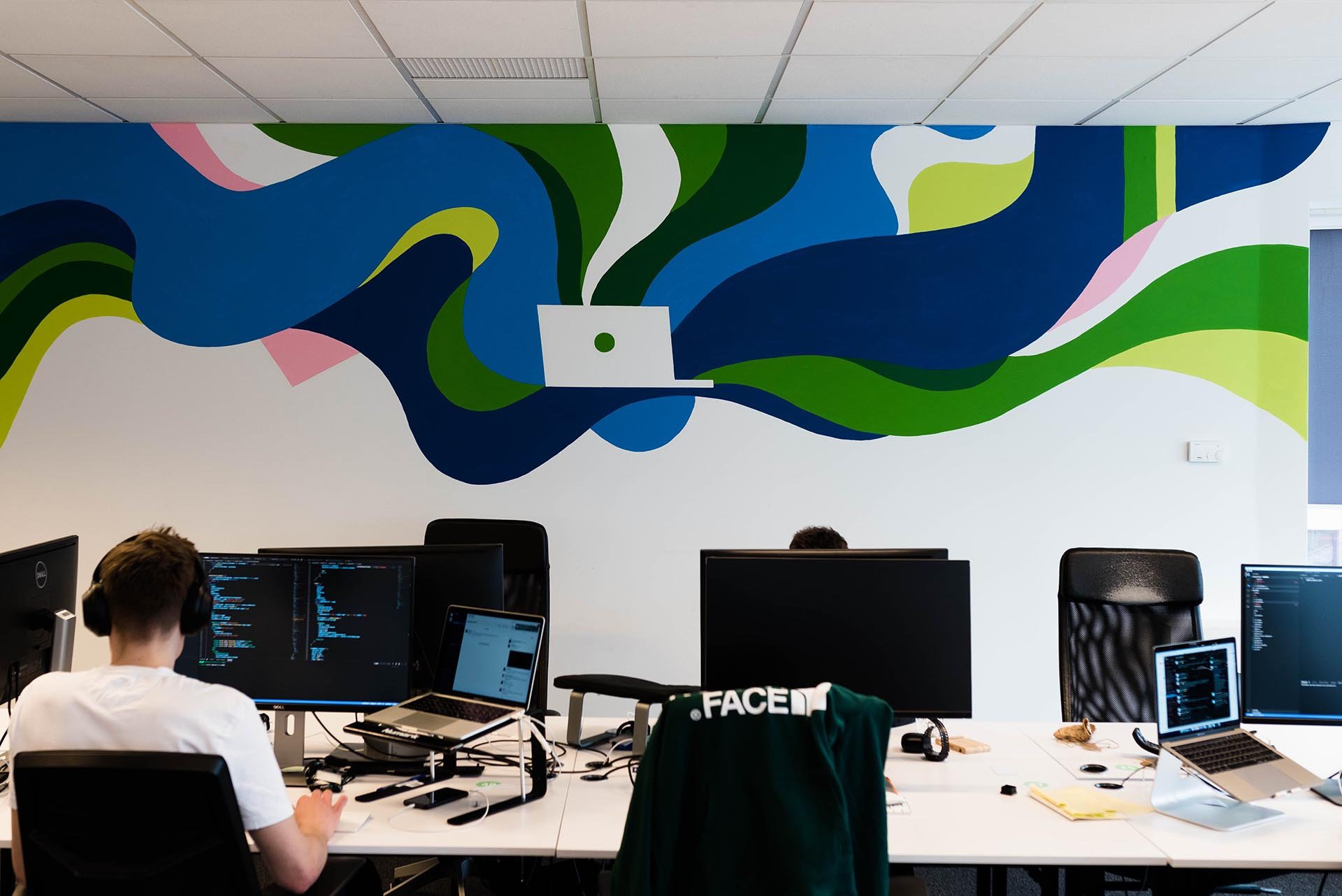Room Planning with AR: Technologies & Considerations

In the rapidly evolving landscape of retail technology, augmented reality (AR) is reimagining the way consumers interact with products and spaces. As one delves deeper into the various applications of AR, one stands out, captivating both retailers and consumers alike: AR room planning.
Through AR-enabled room planning apps, customers can transform their spaces virtually, testing out new designs, placements, and products with just a few swipes on their mobile phones. It's a solution that not only improves the shopping experience but also drives key retail metrics such as engagement, conversion, and brand loyalty.
In this article, we take a look at AR room planning apps, focusing on key technologies and considerations when building such products.
The rise of augmented reality in retail
The retail sector, always on the lookout for ways to enhance customer experiences and increase sales, has found a promising ally in augmented reality. This dynamic technology has quickly moved from the realm of science fiction to practical application, transforming the landscape of consumer engagement and product visualization.
Augmented reality overlays computer-generated visuals onto our perception of the actual world, creating a combined viewpoint that enhances our physical surroundings.The blend of the digital and the real-world that AR provides allows customers to interact with products in innovative and engaging ways, creating unique shopping experiences that are both practical and entertaining.
Imagine trying on clothes without stepping into a fitting room, visualizing how a new lipstick shade would look on your complexion without applying it, or previewing how a couch would fit in your living room before making a purchase decision. A broad range of businesses, spanning from fashion and beauty to furniture and home decor, have recognized the exciting possibilities of augmented reality and are incorporating it into their online and offline offerings.
Benjamin Moore, for instance, has an AR app that lets users virtually paint their walls with different color options, providing a vivid preview before committing to a specific shade. IKEA, on the other hand, has a mobile app that allows users to virtually arrange furniture in their homes, giving them a better idea of how a piece would fit and appear in their space. These examples illustrate how AR has already started reshaping retail experiences.
 Image source: IKEA
Image source: IKEA
AR allows customers to do all this and more. It reduces the uncertainty involved in online shopping, provides an interactive and immersive experience, and assists consumers in making more informed decisions.
Looking ahead, the proliferation of AR in retail is set to grow thanks to advances in AR technologies. As we delve deeper into this topic, we’ll specifically explore how augmented reality is powering room planning applications.
Technology considerations for AR room planning apps
Before deciding on a technology stack for an AR-powered room planning app, one needs to consider a couple of factors. Let’s delve into these crucial considerations, explaining their roles in designing a robust AR room planning application.
Marker-based AR vs. Markerless AR
Marker-based AR applications are designed to detect specific markers or objects in the real-world environment and superimpose virtual objects onto them. A user's smartphone camera reads the visual input, identifies the marker, and then decides how and where to place virtual content.
This approach is commonly used in face filter applications where the AR system identifies facial markers such as eyes, nose, and mouth to overlay virtual effects. However, one limitation of marker-based AR is its dependency on the marker. If the camera loses sight of the marker, for instance, when a user moves the phone, the virtual object also disappears. The virtual object will only reappear once the camera relocates the marker.
In contrast, markerless AR applications function independently of specific markers. They utilize various sensors embedded in a mobile device to determine the device's position and orientation, subsequently overlaying virtual elements. Accelerometers, for instance, measure the acceleration applied to the device; gyroscopes measure the angular speed around all axes in a 3D space; and magnetometers measure the ambient magnetic field in all axes.
This approach is incredibly versatile, as it does not require predefined markers to function. The possibilities for applications are vast, spanning from games that interact with the environment to apps that provide information overlays relevant to a user's current location.
The choice between marker-based and markerless AR depends on the intended product concept, which will directly impact the required technology stack for the mobile app and the necessary expertise of the development team. In some instances, advanced AR applications might necessitate a combination of both marker-based and markerless features to deliver the intended user experience.
Platform-dependent capabilities
When deciding on the technology for an AR room planning app, one crucial factor to consider is the ability to maximize the hardware capabilities of Android and iOS devices. The camera, acting as the app's eyes, captures real-time video and spatial data that the AR software uses to overlay virtual elements.
GPS functionality is another key hardware capability, particularly for location-based or markerless AR, which anchors virtual objects in real-world locations.
Additionally, the accelerometer, gyroscope, and magnetometer all work together to detect device movement and orientation, which is crucial for room planning apps that need to comprehend the spatial layout of the environment.
Other hardware elements, like Bluetooth and microphones, can also further enrich the AR experience. Specific to iOS, to be able to use RoomPlan (more on this AR technology below), developers need to build the app for at least iOS 16. Therefore, understanding the unique strengths and limitations of both Android and iOS platforms is essential for optimizing the AR app's performance and user experience.
Technologies in building AR room planning apps
The cornerstone of any AR tech stack is an augmented reality software development kit (SDK), which facilitates the integration of virtual content with the real world. These software tools and libraries power fundamental AR capabilities, such as tracking the environment, overlaying 3D content, and understanding lighting conditions.
The optimal SDK would depend on your product concept, and your technology team would be in the best position to advise you on the right one. Nonetheless, a few SDKs stand out as the most frequently utilized in the industry.
- Vuforia, a market-leading AR SDK, offers a wide array of functionalities. These include text recognition, 2D and 3D object recognition, the creation of 3D geometric maps, the transformation of static augmented images into motion videos, and storage options both in the cloud and on devices, among others.
- Google's ARCore is a toolkit tailored for Android devices, compatible with Java/OpenGL, Unity, and Unreal. ARCore is adept at understanding the environment, such as by identifying horizontal surfaces for the placement of virtual objects. Furthermore, it enables motion tracking and light estimation, contributing to the natural appearance of virtual objects within a space.
- Apple’s ARKit is exclusively designed for iOS devices like iPhones and iPads. It leverages a technology called Visual Inertial Odometry, which tracks the surrounding environment and identifies device movements within a room. Using ARKit often necessitates the use of additional tools from Apple's suite, including RealityKit, RoomPlan, Reality Composer, and Reality Converter.
In addition to an augmented reality SDK, development teams also need to deploy AR room planning tools. These make it easier to design and render 3D environments, especially for specific use cases like room planning. They provide higher-level functionalities, such as 3D graphics furniture rendering, physics simulation, and animation, making it more straightforward for developers to create complex 3D scenes and interactions.
To simplify, you can think of AR SDKs as the foundation of an AR app that provides core AR features, while room planning tools are specialized tools that help developers efficiently create detailed and interactive 3D environments for their AR apps. Here are some room planning tools to consider:
- SceneKit is a high-level framework from Apple for rendering 3D graphics. It’s often used to create and visualize scenes and 3D objects (e.g., furniture, plants, etc.). SceneKit works together with ARKit to create immersive AR experiences, such as allowing users to interact with 3D objects in the real world.
- RealityKit is a newer Apple framework designed specifically for AR. It simplifies the process of integrating 3D content in AR applications by automatically handling complex tasks like lighting, rendering, and camera effects. This tool allows developers to create more realistic and immersive AR experiences with less manual coding.
- RoomPlan is a groundbreaking Swift API specifically designed for room modeling and decoration within Apple's RealityKit. It enables AR apps to scan rooms and create precise 3D models, allowing users to virtually transform their spaces by introducing new objects. Ideal for furniture retailers, it allows them to build captivating AR showrooms, filling spaces automatically with their products. RoomPlan advances space redesign by generating accurate 3D models and streamlining decision-making processes.
Use case: Furniture showroom app
Using the RoomPlan API tool, Netguru developed an AR room planning mobile app that transforms the way furniture sellers create showrooms. This technology empowers customers to virtually clear rooms and replace existing pieces with 3D models, taking interior design to a whole new level.
The first objective of this project was to enhance the accuracy of RoomPlan for iPhone devices, aiming to achieve a high degree of precision in room scanning. The target was to elevate the API's precision to a staggering 95%. This involved rigorous identification and optimization of the API parameters, coupled with a systematic testing process to ensure the achieved accuracy level was consistent and reliable.
The second objective entailed the design and development of a sophisticated algorithm capable of auto-populating the scanned rooms with 3D furniture models. The algorithm was based on extensive user data analysis to identify the most effective furniture placement strategies. Rigorous testing ensured the algorithm's efficiency and correct functionality, allowing for an authentic and seamless virtual redesign experience.
The final objective focused on creating a user-friendly interface that allows swift and intuitive furniture selection and placement in the room. The fundamental design principles for the RoomPlan-powered app were simplicity and usability. The system also ensured the accuracy of furniture placement within the scanned room, providing furniture shoppers with a realistic preview of the room redesign.
Business case for the furniture showroom app
This app showcases how retail businesses can devise efficient, cost-effective solutions for space redesign. By generating precise 3D room models, it allows for more accurate visualization, which in turn enables retailers to make informed design decisions. The ability to quickly scan rooms and auto-fill them with new furniture not only saves time but also reduces costs associated with traditional room staging.
Additionally, the RoomPlan API enhances the app’s aesthetic appeal. By auto-populating rooms with visually appealing furniture, businesses can create inviting and eye-catching spaces, thereby elevating the customer experience and strengthening brand image.
This use case also offers an environmentally conscious aspect. The automatic furniture placement feature eliminates the need for physical transportation and the arrangement of furniture for visualization purposes, which contributes to more sustainable operations.
Challenges in AR room planning
Building a room planning AR app is marked by a wide variety of technical, creative, and resource-related challenges. The following are some key challenges that project teams often face during this process:
- Determining the appropriate SDK: One of the initial challenges in AR room planning is selecting the right SDK for the task at hand. This choice has a consequential role in the app's functionality and user experience. The right room planning SDK depends on multiple factors, including the platform (iOS or Android), features required, and the team's familiarity and expertise with the SDK.
- Initial implementation cost: Implementing AR room planning for the first time can be expensive due to the complexity of the technology and the lack of established standards. The need for a skilled development team, the requirement for specialized software, and the time required for research and development are typically what drive costs. Furthermore, the absence of widely recognized standards can lead to unforeseen difficulties and adjustments during the development process.
- Detection and placement accuracy: Achieving a high degree of accuracy in object detection and positioning usually entails expertise in machine learning and computer vision. Inaccuracies can result in poor user experience, so this aspect of the development process demands meticulous attention to detail.
- Creating realistic AR elements: Designing realistic AR elements that blend seamlessly with the real world involves meticulous modeling, texturing, and lighting techniques. Making virtual objects look natural when overlaid on the real environment can be a genuine creative and development challenge. Achieving this level of realism is crucial for a compelling and immersive AR experience.
- Device compatibility: With the wide range of devices available, optimizing for compatibility can be a formidable challenge. Each device has different capabilities, screen sizes, and hardware features that can affect the performance and appearance of the AR elements. The development team must be vigilant to optimize the AR room planning app for a broad spectrum of devices.
- Security and privacy concerns: Room planning apps need to handle the data they collect responsibly, especially since it can capture sensitive information about a user's private spaces. Establishing robust security measures and transparent privacy policies is necessary to build user trust and comply with data protection regulations.
Embracing AR in next-generation retail
Augmented reality emerges as an exciting innovation in the field of room planning as we herald in a new era of immersive retail experiences. AR is pushing the frontiers of consumer experience by allowing consumers to interact with products in a profoundly engaging way by blending the digital and physical worlds.
However, it's important to recognize that the path to realizing its full potential is not without hurdles. From selecting the right technology stack to overcoming technical intricacies and privacy concerns, AR room planning demands a strategic, dedicated, and iterative approach.
Yet, the horizon is promising. We stand at the precipice of an exciting new paradigm, where shopping for your next piece of furniture may be as simple as lifting your smartphone, scanning your room, and watching as it transforms before your eyes.
Businesses that adapt to and incorporate AR into their retail strategy stand to gain a significant competitive edge in this dynamic market landscape. It's an exciting future, one that beckons closer every day. Be ready to welcome it.








